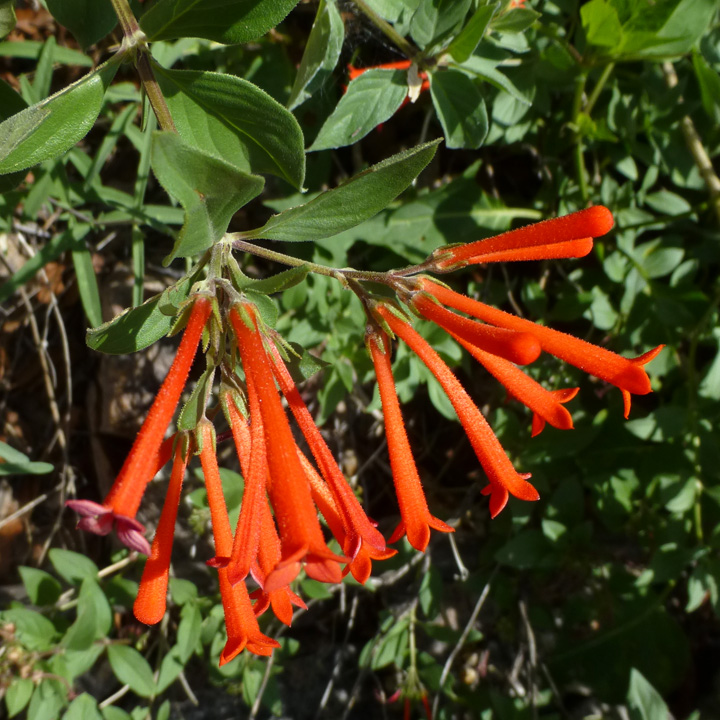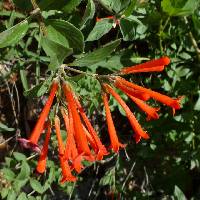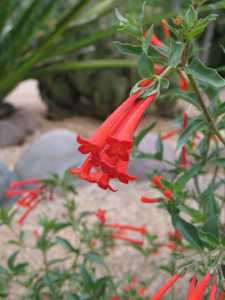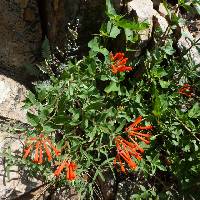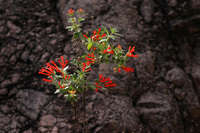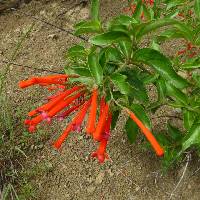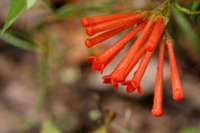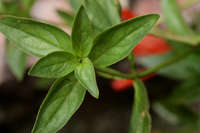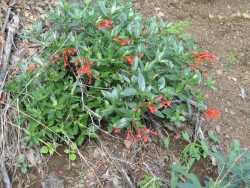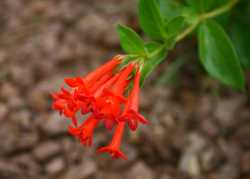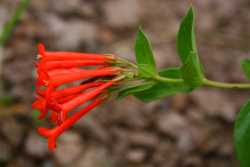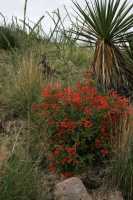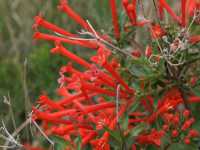Plant: Shrubs or suffrutescent herbs; to 1.5 m high
Leaves: 3-4 per node, glabrous or velvety, 2-9 cm long, short- petiolate; blades ovate to lanceolate, the apices acuminate to long-attenuate, the margins scabrous; stipular sheath long cuspidate to multi-aristate.
Flowers: few to many in cymes, villous outside with short coarse hairs; calyx lobes lanceolate to filiform, erect; corolla tube slender, widening toward throat, red, 15-32 mm long, the lobes ovate, 2-3 mm long; stamens mostly included, the anthers subsessile, 2.5-3 mm long; styles filiform, more or less exserted at maturity
Fruit: a didymous-globose capsule, 5-7 mm broad, the calyx lobes persistent. SEEDS numerous, compressed-winged, brown
Misc: Rocky slopes and canyon bottoms; pine-oak and juniper-oak woodlands; oak chaparral; granite sand; 750-2450 m (2500-8000 ft); May-Oct
REFERENCES: Dempster, Lauramay T. 1995. Rubiaceae. J. Ariz. - Nev. Sci. 29(l): 29.
Common Name: firecrackerbush
Duration: Perennial
Nativity: Native
Lifeform: Shrub
General: Shrubs to woody herbs reaching 1.5 m tall, the older bark dark gray to white.
Leaves: Whorled with 3-4 per node, sessile or short-petiolate, glabrous or velvety, 2-9 cm long; blades ovate to lanceolate, apices acuminate to long-attenuate, margins scabrous; stipular sheath long-cuspidate to multi-aristate.
Flowers: Red, in terminal clusters, the flowers villous outside with short coarse hairs; calyx lobes 4, lanceolate to filiform, erect; corolla tube red, slender, widening toward throat, 15-32 mm long, with 4 ovate lobes, 2-3 mm long; stamens 4, mostly included, the anthers subsessile, 3 mm long.
Fruits: Globose capsule 5-7 mm broad, with persistent calyx lobes; seeds numerous, compressed-winged, brown.
Ecology: Found on rocky slopes and canyon bottoms from 2,500-8,000 ft (762-2438 m); flowers May-October.
Distribution: s AZ, s NM, s TX; south to s MEX.
Notes: Distinguished by being a mostly low-growing shrub, often with multiple erect branches from the ground; whorled leaves with rough-hairy margins; especially distinctive are the showy, red, tubular flowers followed by globose, 2 to 4-lobed fruits tightly wrapped by hairy calyces with claws.
Ethnobotany: Root used by indigenous people in northern Mexico as a cardiac stimulant, to treat dysentery, hydrophobia, and heat exhaustion, and to stop bleeding; also a modern cultivated ornamental.
Etymology: Bouvardia is named for Charles Bouvard (1572-1658) who was superintendent of the Jardin du Roi in Paris; ternifolia means 3-leaved, referring to the whorls of three leaves per node, though there are also sometimes 4 leaves per node in this species.
Synonyms: Bouvardia glaberrima
Editor: SBuckley 2010, FSCoburn 2015, AHazelton 2015


